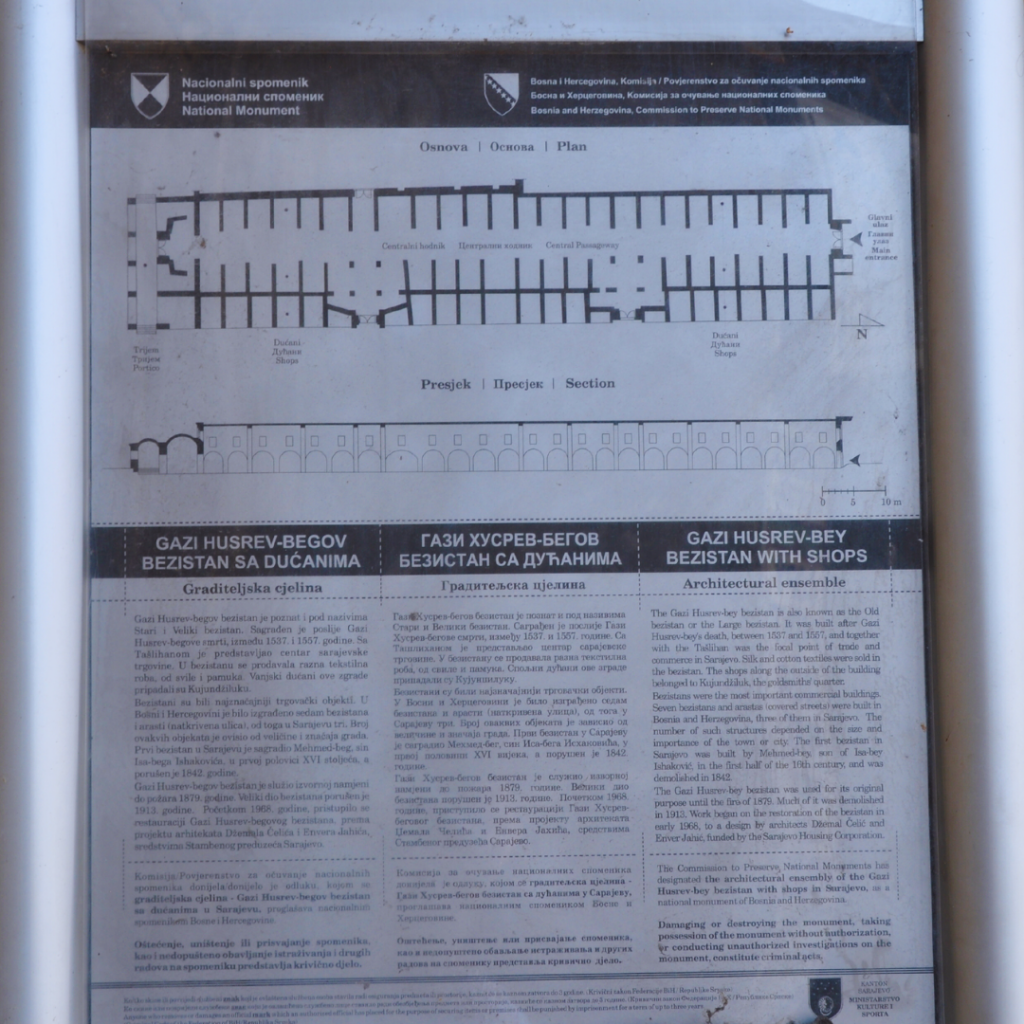Gazi Husrev-beg Bezistan is nestled in the heart of Baščaršija, the vibrant bazaar district of Sarajevo, facing Sarača Street. This historical gem lies just 50 meters west of the iconic Begova Mosque and the Sahat-kula (Clock Tower).
Discovering the Past
Sarajevo, like many oriental cities, was divided into two main parts: residential neighborhoods or “mahalas” and the bustling marketplaces known as “čaršija.” The residential areas gracefully spread across the surrounding hills, while in the čaršija, rapid commerce flourished. During the 16th century, the čaršija reached its peak, boasting an impressive array of 80 different crafts, all organized into powerful guilds or “esnaf.” Each craft formed its own street or section within the market, with famous names like Kazandžiluk, Kujundžiluk, Kazazi, Franačka čaršija, Halači, Mudželiti, and more, contributing to the unique charm of Sarajevo’s čaršija.
A Hub of Trade and Craftsmanship
The čaršija was a hub of commerce, offering a rich variety of locally-crafted goods. Sarajevo’s artisans were renowned for producing not only for locals but also for export to other regions. To support this bustling marketplace, a network of commercial buildings was established, including “bezistan,” in addition to “han” (inns) and “karavan-saraji” (caravanserais), along with countless shops, and warehouses.
A Tale of Bezistan
Notably, the number of these structures varied depending on the size and importance of each city. Larger cities, like Istanbul, could boast three bezistans, while smaller towns might have only one. In Bosnia and Herzegovina, there were seven bezistans and arasts in total, with two bezistans and one arasta in Sarajevo alone. Bezistans often bore the name of their founders or were named after the type of fabric predominantly sold within or their place of origin. For instance, one in Istanbul was known as Sandal-bedesten due to the sandal silk fabric, while one in Sarajevo, which still stands today, is named Brusa-bezisten, after the cotton fabric “brusa.”
A Glimpse into Sarajevo’s Past
All three of Sarajevo’s bezistans came into existence between 1463 and 1551, with the Banja Luka bezistan following after 1587, but before 1659, and the Travnik bezistans emerging in the sixth decade of the 18th century. Of the three Sarajevo bezistans, two have been preserved to this day.
Mehmed-beg’s Legacy
The first bezistan in Sarajevo, constructed in the early 16th century, was commissioned by Mehmed-beg, the son of Isa-beg Ishaković. It was located near Kolobara Inn, in the Trgovci area, just north of Brusa-bezistan. Unfortunately, it was significantly damaged during Eugene of Savoy’s campaign in 1697 and eventually demolished in 1842. Its exact architectural details remain elusive.
Brusa-Bezistan: Rustem-paša’s Masterpiece
On the other hand, Brusa-bezistan, built in 1551, holds a special place in Sarajevo’s history. Its founder, Rustem-paša, originally from Sarajevo or its vicinity, considered this bezistan his most significant legacy in his hometown. Situated on the eastern side of Tašlihan, these two structures were closely connected. Traders within the bezistan could directly interact with Venetian and Dubrovnik merchants staying in Tašlihan.
A Mysterious Past
Oddly, none of Gazi Husrev-beg’s vakufnames (endowment deeds) provide any details about Bezistan and Tašlihan. However, in the Dubrovnik archives (ACTA TURCARUM, series LXX number 3217), an undated petition from Sarajevo’s traders and residents to the Dubrovnik prince and nobility was discovered. In this plea, they requested thirty skilled craftsmen in wall construction to come to Sarajevo. The request stemmed from a letter sent by Dubrovnik friends, Ulam-paša and Murad-beg, the Pasha of Požega, who had dispatched a certain Mahmud to bring these artisans. The craftsmen were primarily needed to complete Husrev-beg’s caravanserai. These artisans would receive payment, gifts, and travel expenses from the “mutevelija” and “nazir” (similar to stewards and overseers). The citizens of Sarajevo pledged to assist the craftsmen. This document suggests that the inhabitants of Sarajevo, as well as Dubrovnik traders in the city, required a fire-resistant building due to the frequent and devastating fires. In the same year, the building was completed. This petition was drafted during the rule of the Bosnian Pasha Ulam-paša, who arrived in Bosnia after June 17, 1541 (the day Husrev-beg passed away) and stayed until 1543. Considering that the document mentions Murad-beg as the Pasha of Požega, a position he acquired in 1542, this petition was likely written in 1542 or 1543, coinciding with the completion of the caravanserai. Though the bezistan is not mentioned in the petition, it is reasonable to assume both buildings were constructed simultaneously (Kreševljaković, p. 236).
The Birth of Gazi Husrev-beg Bezistan
Based on these findings, it is evident that the bezistan was constructed concurrently with Tašlihan, between 1537 and 1557. It stood next to the caravanserai, serving as the heart of Sarajevo’s trade, particularly in imported textiles. Over the centuries, the bezistan faced several fires, including the major blazes of 1697, 1831, and 1879. However, none managed to fully destroy it. The merchants in the bezistan primarily dealt in various textile goods made from silk and cotton, and they were exclusively Muslim and Jewish traders. After 1878, the bezistan also began selling harmonicas, various accessories, and costume jewelry.
A Unique Design
Unlike other trade structures from the Ottoman period, bezistans are notable for their solid construction. They are built from stone, featuring elegant domes or barrel vaults. Most often, they have a rectangular

How to come?

